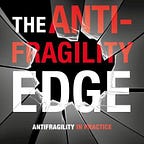Conversations on Antifragility: Practice Beyond the Rhetoric!
In Antifragile: Things That Gain from Disorder (2012), Nassim Nicholas Taleb (@nntaleb) introduced Antifragility.
Some things benefit from shocks; they thrive and grow when exposed to volatility, randomness, disorder, and stressors and love adventure, risk, and uncertainty. Yet, in spite of the ubiquity of the phenomenon, there is no word for the exact opposite of fragile. Let us call it antifragile.
First, Taleb distinguishes between the fragile, robust, and antifragile (the Triad):
the fragile wants tranquility, the antifragile grows from disorder, and the robust doesn’t care too much.
Next, Taleb advances that
by grasping the mechanisms of antifragility we can build a systematic and broad guide to non-predictive decision making under uncertainty in business, politics, medicine, and life in general.
As the world continues to become increasingly interconnected and interdependent, Black Swans — large-scale unpredictable and irregular events of massive consequence — are necessarily becoming more prominent, where it is far more reasonable to figure out if something is fragile than to calculate the risks and probabilities of rare events!
As a result of the proliferation of volatility, uncertainty, complexity, and ambiguity (VUCA), non-predictive decision making (within the context of observing, orienting, deciding, and acting (OODA)) is quintessential!
Theory and Practice
Albert Einstein emphasized the distinction between theory and practice:
In theory, theory and practice are the same. In practice, they are not.
William Edwards Deming emphasized the importance of theory:
Experience by itself teaches nothing . . . Without theory, experience has no meaning. Without theory, one has no questions to ask. Hence, without theory, there is no learning.
And Taleb emphasizes the secrets only practice can reveal:
For a theory is a very dangerous thing to have. And of course one can rigorously do science without it. What scientists call phenomenology is the observation of an empirical regularity without a visible theory for it. In the Triad, I put theories in the fragile category, phenomenology in the robust one. Theories are superfragile; they come and go, then come and go, then come and go again; phenomenologies stay, and I can’t believe people don’t realize that phenomenology is “robust” and usable, and theories, while overhyped, are unreliable for decision making — — outside physics.
The key is that the significant can only be revealed through practice.
No, we don’t put theories into practice. We create theories out of practice.
It is just that things that are implemented tend to want to be born from practice, not theory.
There are secrets to our world that only practice can reveal, and no opinion or analysis will ever capture in full. This secret property is, of course, revealed through time, and, thankfully, only through time.
Thus, practice beyond the rhetoric!
Antifragility Conversations
Throughout 2015, Barry Bettman (@barrybettman) and Si Alhir (@SAlhir) hosted various conversation panels focused on exploring the practice of antifragility (that is, Practice Beyond the Rhetoric) through the following questions:
- How have you interpreted Taleb’s concept of Antifragility?
- How have you translated your interpretation into practice?
- What are the results and impacts of your efforts?
All the events / conversations are available here (Audio).
Event #1 (March 18, 2015): Europe Group
- Semira Soraya-Kandan (@SemiraSK)
- Elinor Slomba (@artsint)
- Vincenzo De Florio (@EnzoDeFlorio)
- Mark Ferraro (@mark4ro), author of Conscious Agility (Conscious Capitalism + Business Agility = Antifragility)
Event #1 (March 18, 2015): North America Group
- Christine Ogozaly (@ceogozaly1)
- Luc Taesch (@luctaesch)
- Tom Sylvester (@tsylvest)
- Brad Barton (@Brad_Barton), author of Conscious Agility (Conscious Capitalism + Business Agility = Antifragility)
Event #2 (May 6, 2015)
- Barbara Trautlein (@btrautlein), author of Change Intelligence
- Tony Bendell (@AntiFragileUK), author of Building Anti-Fragile Organisations
- Jennifer Sertl (@JenniferSertl), author of Strategy, Leadership and the Soul
- John King (@flowdaddy13), author of Tribal Leadership
- Lisa Nemeth Cavanagh (@lnemethcavanagh)
- Andrew Black (@AntifragileDoc), author of The Antifragile Doctor
Event #3 (June 30, 2015)
- Paul Gibbons (@PaulGGibbons), author of The Science of Successful Organizational Change
- Leandro Herrero (@LeandroEHerrero), author of Homo Imitans and Viral Change
- Lisa Nemeth Cavanagh (@lnemethcavanagh)
Event #4 (August 19, 2015): Life Lessons from Artists
Event #5 (August 26, 2015): Enterprise (Business and Technology) Architecture
Event #6 (September 2, 2015): The Science of Successful Organizational Change
Event #7 (September 9, 2015): Viral Change
Event #8 (September 30, 2015)
- Judith E. Glaser (@CreatingWE), author of Conversational Intelligence (C-IQ) and Creating WE
- James Key Lim (@jameskeylim)
Event #9 (October 7, 2015): Social Business & Digital Transformation
- David Cushman (@davidcushman), author of The 10 Principles of Open Business
- Anne McCrossan (@Annemcx)
- Todd Nilson (@toddnilson)
Event #10 (November 4, 2015): Sun Tzu’s Art of War
- Mark McNeilly (@markmcneilly), author of Sun Tzu and the Art of Modern Warfare and Sun Tzu and the Art of Business: Six Strategic Principles for Managers
- Becky Sheetz-Runkle (@BeckySheetz), author of Sun Tzu for Women: The Art of War for Winning in Business and The Art of War for Small Business: Defeat the Competition and Dominate the Market with the Masterful Strategies of Sun Tzu
The Antifragility Edge: Antifragility in Pracitce
Much of Si Alhir’s (@SAlhir) experience and work has been captured in The Antifragility Edge: Antifragility in Practice.
All thoughts are welcome . . .
Note: This was originally blogged on http://salhir.wordpress.com.
